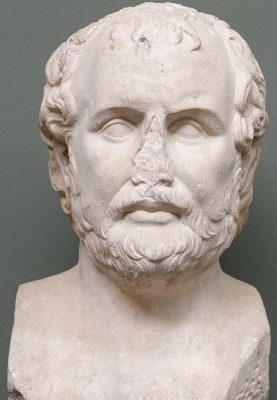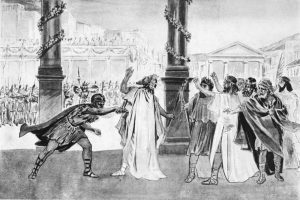Philip II of Macedon was born in 382 B.C. He was the king of Macedonia, starting from 359 B.C. until 336 B.C. His father was King Amyntas III, and his mother was Eurydice I. Philip was not only the father of Alexander the Great, but he was also the main force behind the rise of Macedonia as a military power.
As a youth, Philip was given by Ptolemy of Alloros to Illyria as a hostage following the murder of Philip’s brother, Alexander II. He was retained in Thebes, and there he was taught military tactics and diplomacy by the Greek statesman Epaminondas. Interestingly, it was also during this time that Philip became involved in a homosexual relationship with the Greek generals Pelopidas and Pammenes.
Philip went back home to Macedonia in 364 B.C., and five years later, King Perdiccas III, his other brother, died while clashing against the Illyrians. Before Perdicas left to battle the Illyrians, he assigned Philip to govern his newborn son, Amyntas IV. However, instead of acting as regent for the infant, Philip seized the throne. Philip then set his sights on the kingdom’s territorial concerns. The Thracians and the Paeonians had intruded and encroached on the eastern portions of Macedonia, while the Athenians had occupied the village of Methoni. In 359 B.C., he offered peace settlements to the Thracians and Paeonians, establishing temporary peace.
Military Innovations
After freeing himself from the burden of fighting his enemies, he focused on tightening his grip on the throne and strengthening his military might. He doubled the numbers of his foot soldiers and horse-mounted soldiers and improved the training system. To fuel his soldiers’ motivation, Philip established a better promotion and extra payment system for soldiers who showed remarkable dedication and courage. An important change that Philip introduced was the Macedonian phalanx, which was a formation composed of 256-foot soldiers all carrying a sarissa, a spear that measured up to 6 meters long and later became commonly used by the Macedonian army.
Military Accomplishments
In 358 B.C., Philip launched an attack against the Illyrians and subsequently crushed them the following year. This was after Philip married the Illyrian king’s great-granddaughter, Audata. The attack resulted in the death of 7,000 Illyrians, and this triumph enabled him to strengthen his power as ruler.
The following year, Philip went to surround the city of Amphipolis in 357 B.C. Amphipolis had a rich gold mine, which was why the Athenians tried to invade it earlier. However, the Athenians failed, and Philip made an agreement with them that if he conquered the city, he would lease it to them. Philip’s motive for this move was that he wanted the Athenians to hand over the city of Pydna in exchange for Amphipolis. The Athenians accepted the offer, and Philip went on to take the city. Nonetheless, Philip disregarded the agreement and occupied Pydna as well, thus acquiring two cities. Athens issued a declaration of war against Philip, and he responded by forging an alliance with the Chalcidian League, a confederacy of Greek cities.
Philip married the Princess of Epirus, Olympias, in 357 B.C. The following year, their son, Alexander, was born. Philip continued his military affairs by marching his troops to the city of Krenides and occupying it. He then built intimidating military bases there to maintain command of the region, which was rich in gold. Philip used the gold to fuel his later military operations.
In 355 and 354 B.C., he blockaded the city of Methoni, which the Athenians occupied. According to the ancient Greek scholar Didymus Chalcenterus, while Philip was inspecting the siege machines, his eye was hit by an arrow. Apparently, this injury was prophesied by the Oracle at Delphi, whom Philip had consulted after peeping into the bedroom and seeing his wife, Olympias, having sex with a snake. The Oracle told Philip that the snake was the god Zeus-Ammon, the real father of Alexander. The oracle then added that Philip had offended Zeus Ammon, and the god would take his eye that witnessed the sexual intercourse. Methoni was eventually captured, and Philip’s eye was later taken out through surgery.
Philip became embroiled in the Third Sacred War when, in 354 B.C., the Thessalian League asked him to take control of the city-state of Pagasae. The following year, Philip was again requested to help out in battling the despot Lycophron, who was backed by Onomarchus. Philip attacked Thessaly, crushing the Phocians and eventually pushing out the brother of Onomarchus. Later that year, Philip suffered two losses in a row at the hands of Onomarchus. He looked for revenge and prepared an army made up of 3,000 horse-mounted soldiers and 20,000 infantrymen, strengthened by troops sent by the Thessalian League. With this force, Philip marched to confront the enemy in a battle that came to be known as the Battle of the Crocus Field. Philip crushed the opposition, killing 6,000 Phocians and capturing 3,000 more. His triumph was so impressive that he was made head of the Thessalian League.
In 348 B.C., Philip blockaded the city of Olynthus. Olynthus had a strategic location, being built on top of two hills that stand about 40 meters high. It was a former ally of Macedonia but later transferred its loyalty to Athens. However, when Philip attacked Olynthus, Athens did not come to its rescue. In the same year, Philip seized control of Olynthus. Following this, Philip marched his forces to the eastern parts of the Hebrus River and forced the prince of Thrace, Cersobleptes, to acknowledge Macedonian rule. Cersobleptes was forced to hand over one of his sons as a hostage to Philip. Later, in the conflict between the Phocians and Thebes, Philip acted as a mediator. However, his clashes against the Athenians flared up from time to time. Soon, Athens sent proposals for peace, and this resulted in the end of the conflict.
In 340 B.C., Philip ordered his troops to surround Perinthus. He followed this up by blockading another city, Byzantium, the following year. These military operations both faltered, and Philip’s prestige declined. He sought to restore his reputation in 338 B.C. by crushing a combined force of Athenians and Thebans. After this, he devastated the Phocian town of Amfissa because the inhabitants farmed an area of fertile land that was part of Delphi. Philip thus regained his reputation and was granted leadership of the League of Corinth, a confederacy of Greek states opposing Persia.
Military Operations in Asia
As early as 352 B.C., Philip had been at work opposing Persia’s Achaemenid Empire. He gave refuge to its enemies, such as the Persian general Artabazos II, a Parthian named Amminapes, and Sisines, a man of Persian nobility. Providing refuge to Persia’s enemies kept Philip abreast of any news concerning Persia.
In 336 B.C., Philip planned the liberation of Greeks on Anatolia’s western shores, which were under the dominion of the Achaemenid Empire. For this campaign, he sent his general, Parmenion, along with a Macedonian nobleman named Andromenes, his officer Amyntas, and his courtier, Attalus. The Greeks fought well but soon received word that Philip had been killed and was replaced by his son, Alexander. This news weakened the morale of the Macedonian army and led to their defeat at the hands of the Aechmenids.
Death
In October of 336, at the Macedonian capital of Aegae, Philip attended the wedding of his daughter, Cleopatra, to Alexander I of Molossia. As Philip was entering the theater, he was stabbed in the ribs by Pausanias, one of his bodyguards. Philip slumped, and Pausanias sprinted to his horse outside and rushed towards the outskirts of the city where his conspirators were waiting to help him escape. Philip’s other bodyguards chased him, and in the heat of the pursuit, Pausianas’ horse stumbled and crashed to the ground. Pausanias was then killed by Philip’s other bodyguards.
The motives behind Pausianas’ actions are not clear to this day. Even historians in ancient times could not give a rational explanation for Pausianas’ deed. There was talk that Pausanias had somehow been offended by Attalus, Philip’s courtier and uncle-in-law. A Latin writer named Justin, who lived in the second century, says that Philip’s son, Alexander, and his wife, Olympias, were the ones behind the assassination, or at least knew something about the plot. He says that Olympias laid a crown on Pausianas’ body and even required yearly offerings to the assassin’s grave. However, modern historians do not give much weight to either of these theories, especially the one linking Alexander and Olympias to the murder. Philip II was much too powerful at the time, and his troops were loyal to him. It was irrational for mother and son to have plotted against Philip at the time.
The Tomb of Philip II
In 1977, four tombs were discovered by Greek archaeologists close to the modern-day town of Vergina in Greece. This spot used to be where the ings of Macedonia were buried, and two of the four tombs were found to be undisturbed since ancient times. The archaeologists eventually learned that Tomb 2 contained great treasures. Debates about which of the two tombs went on for years, but scholars who believed that Tomb 2 was the one that contained Philip’s body pointed at the skull that had a damaged right eye caused by a pointed object’s penetration. In 2015, this claim was opposed by two scientists who claimed that Philip was contained in Tomb 1, while the bodies in Tomb 2 were those of King Arrhidaeus and Eurydice II. However, Greece’s Ministry of Culture and Sports disagreed with this claim. Subsequent research on the site led to more evidence supporting the claim that Philip II was buried in Tomb 2.

